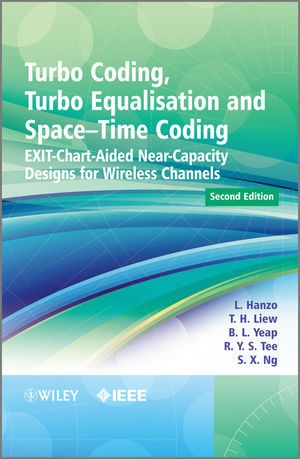Read more
Informationen zum Autor Lajos Hanzo received his Doctorate in 1983 from the Technical University of Budapest. In 2010 he was awarded the university's highest honour, namely the Honorary Doctorate "Doctor Honaris Causa". During his 34-year career in telecommunications he has held various research and academic posts in Hungary, Germany and the UK. Since 1986 he has been a member of academic staff in the School of Electronics and Computer Science, University of Southampton, UK, where he currently holds the Chair in Telecommunications and he is head of the Communications Research Area. He is also a Chaired Professor at Tsinghua University, Beijing, China. Lajos Hanzo has co-authored 20 John Wiley/IEEE Press books on mobile radio communications, and published over 1000 research papers and book chapters at IEEE Xplore. He has also organised and chaired major IEEE conferences, such as WCNC'2006, WCNC'2009, VTC'2011, presented Tutorial/overview lectures at international conferences. Tong Hooi Liew received his PhD degree in 2001 from the University of Southampton, UK. Following a one year spell as postdoctoral research fellow, he joined Ubinetcs in Cambridge, UK in algorithm design for 3G mobile station. He then joined TTP Group as a consultant working in mobile TV. Currently he is working as a consultant for Aeroflex in both physical layer and Layer 2 in various wireless technologies like 3G HSPA, HSPA+, LTE and advanced LTE wireless systems. He has over 40 publications in books, book chapters, journal and conference papers. His research interests are associated with coding and modulation for wireless channels, space-time coding and adaptive transceivers. Ronald Yee Siong Tee received his PhD degree from the University of Southampton in 2008. He was previously involved in research collaboration with Nokia UK in signal processing and handwriting recognition in 2000. From 2001 to 2002 he worked at Nortel Networks Switzerland in the area of data and optical network. In 2003, he was with a local Singapore IT company, where he headed the telecommunication business. Dr. Tee is the recipient of several academic awards, including the Overseas Research Scheme, the ASEAN scholarship, and the Malaysian Government studentships. He is currently with Ernst & Young London, working in forensic technology and electronic disclosure. Bee Leong Yeap received his PhD in 2000 from the University of Southampton, having been fully funded by the University's Communications Group and the Overseas Research Studentship. He continued his research as a postdoctoral research fellow in Southampton until 2004, working on EU projects such as TRUST and SCOUT. In 2004, he joined RadioScape Plc, London to develop commercial DAB, DRM and DMB receivers. Subsequently from 2008, he has been with Motorola Ltd, Ashburton designing Point-to-Point Wireless Ethernet bridges, which are used to provide connectivity and backhaul for network carriers, Educational Broadcast Service and Federal agencies. To date, he has published two John Wiley/IEEE Press books and over 30 research papers. His research interests include MIMO systems, turbo coding, LDPC, turbo equalisation, space-time coding and adaptive modulation. Soon Xin Ng received the Ph.D. degree in wireless communications from the University of Southampton, UK, in December 2002. From 2003 to 2006, he was a postdoctoral research fellow working on collaborative European research projects known as SCOUT, NEWCOM and PHOENIX. Since August 2006, he has been a member of academic staff in the School of Electronics and Computer Science, University of Southampton. He is involved in the OPTIMIX European project as well as the IU-ATC and UC4G projects. His research interests include adaptive coded modulation, coded modulation, channel coding, space-time coding, joint source and channel coding, iterative detection, OFDM, MIMO, cooperative communications and distributed ...
List of contents
About the Authors.
Other Related Wiley-IEEE Press Books.
Acknowledgements.
1 Historical Perspective, Motivation and Outline.
1.1 A Historical Perspective on Channel Coding.
1.2 Motivation for this Book.
1.3 Organisation of the Book.
1.4 NovelContributions of the Book.
2 Convolutional Channel Coding.
2.1 Brief Channel Coding History.
2.2 Convolutional Encoding.
2.3 State and Trellis Transitions.
2.4 The Viterbi Algorithm.
2.5 Summary and Conclusions.
3 Soft Decoding and Performance of BCH Codes.
3.1 Introduction.
3.2 BCH codes.
3.3 Trellis Decoding.
3.4 Soft-input Algebraic Decoding.
3.5 Summary and Conclusions.
Part I Turbo Convolutional and Turbo Block Coding.
4 Turbo Convolutional Coding (J. P. Woodard and L. Hanzo).
4.1 Introduction.
4.2 Turbo Encoder.
4.3 Turbo Decoder.
4.4 Turbo-coded BPSK Performance over Gaussian Channels.
4.5 Turbo Coding Performance over Rayleigh Channels.
4.6 Summary and Conclusions.
5 Turbo BCH Coding.
5.1 Introduction.
5.2 Turbo Encoder.
5.3 Turbo Decoder.
5.4 Turbo Decoding Example.
5.5 MAP Algorithm for Extended BCH Codes.
5.6 Simulation Results.
5.7 Summary and Conclusions.
Part II Space-time Block and Space-time Trellis Coding.
6 Space-time Block Codes.
6.1 Classification of Smart Antennas.
6.2 Introduction to Space-time Coding.
6.3 Background.
6.4 Space-time Block Codes.
6.5 Channel-coded Space-time Block Codes.
6.6 Performance Results.
6.7 Summary and Conclusions.
7 Space-time Trellis Codes.
7.1 Introduction.
7.2 Space-time Trellis Codes.
7.3 Space-time-coded Transmission over Wideband Channels.
7.4 Simulation Results.
7.5 Space-time-coded Adaptive Modulation for OFDM.
7.6 Summary and Conclusions.
8 Turbo-coded Adaptive Modulation versus Space-time Trellis Codes for Transmission over Dispersive Channels.
8.1 Introduction.
8.2 System Overview.
8.3 Simulation Parameters.
8.4 Simulation Results.
8.5 Summary and Conclusions.
Part III Turbo Equalisation.
9 Turbo-coded Partial-response Modulation.
9.1 Motivation.
9.2 The Mobile Radio Channel.
9.3 Continuous Phase Modulation Theory.
9.4 Digital Frequency Modulation Systems.
9.5 State Representation.
9.6 Spectral Performance.
9.7 Construction of Trellis-based Equaliser States.
9.8 Soft-output GMSK Equaliser and Turbo Coding.
9.9 Summary and Conclusions.
10 Turbo Equalisation for Partial-response Systems.
10.1 Motivation.
10.2 Principle of Turbo Equalisation Using Single/Multiple Decoder(s).
10.3 Soft-in/Soft-out Equaliser for Turbo Equalisation.
10.4 Soft-in/Soft-out Decoder for Turbo Equalisation.
10.5 Turbo Equalisation Example.
10.6 Summary of Turbo Equalisation.
10.7 Performance of Coded GMSK Systems Using Turbo Equalisation.
10.8 Discussion of Results.
10.9 Summary and Conclusions.
11 Comparative Study of Turbo Equalisers.
11.1 Motivation.
11.2 SystemOverview.
11.3 Simulation Parameters.
11.4 Results and Discussion.
11.5 Non-iterative Joint Channel Equalisation and Decod

